On the Way to the Doctor, 1974 by Charles W. Stewart (1915 – 2001).
Part of a series of unpublished illustrations that were to illustrate Mervyn Peake’s 1950 novel, Gormenghast. (More here.)

On the Way to the Doctor, 1974 by Charles W. Stewart (1915 – 2001).
Part of a series of unpublished illustrations that were to illustrate Mervyn Peake’s 1950 novel, Gormenghast. (More here.)

Mervyn Peake’s Gormenghast trilogy was one of my favorite reads last year, so when I spotted a used copy of the anthology Sometime, Never, I picked it up. Along with novellas by William Golding (Envoy Extraordinary) and John Wyndham (Consider Her Ways), this 1956 includes Peake’s Boy in Darkness, a novel that takes place between the first two Gormenghast books. Gervasio Garvado’s cover illustration seems to depict Peake’s tale. Blurb:
Each of the three tales of imagination in this book is by a master of the art, and in each there is incident and invention enough to surpass most full-length novels.
Envoy Extraordinary, by William Golding, tells of a barbarian genius who arrives in ancient Rome with three inventions–and the results are appalling.
Consider Her Ways, by John Wyndham, presents a shocking and utterly convincing picture of a world of women–without men.
Boy In Darkness, by Mervyn Peake, is a venture into a dream-like world of strangeness and terror–quite unlike anything you have ever read, and unforgettable.
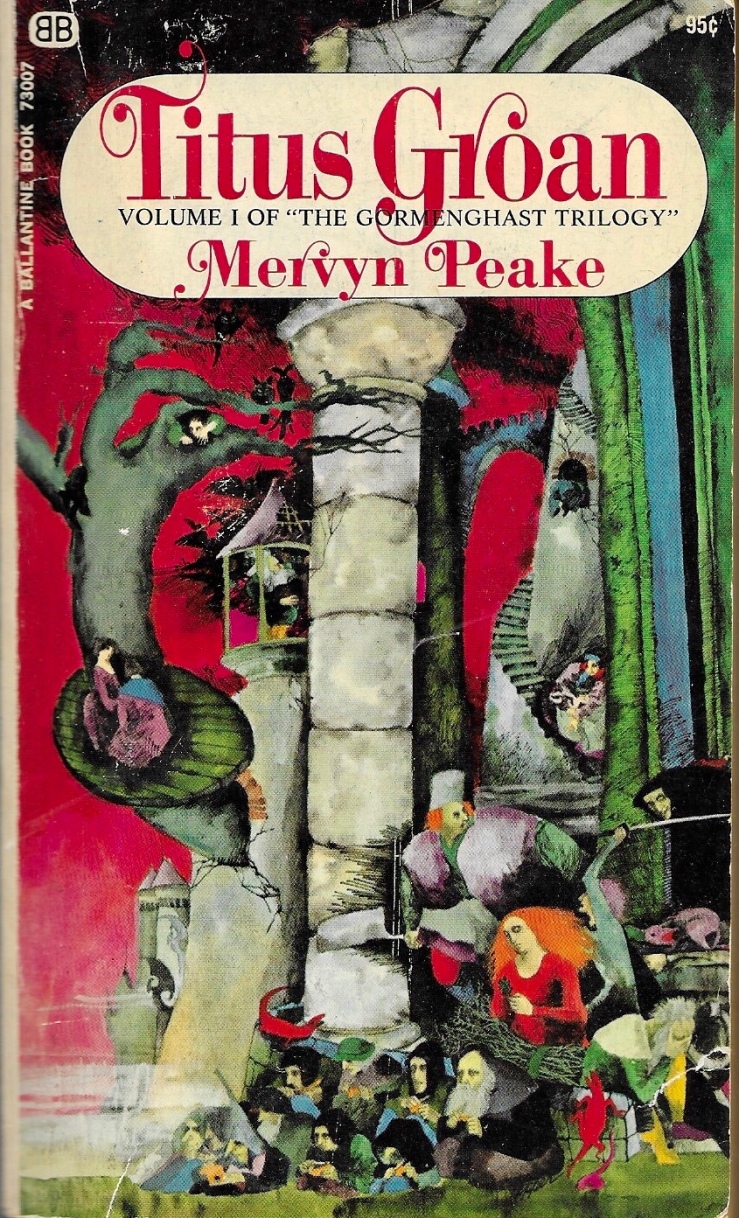
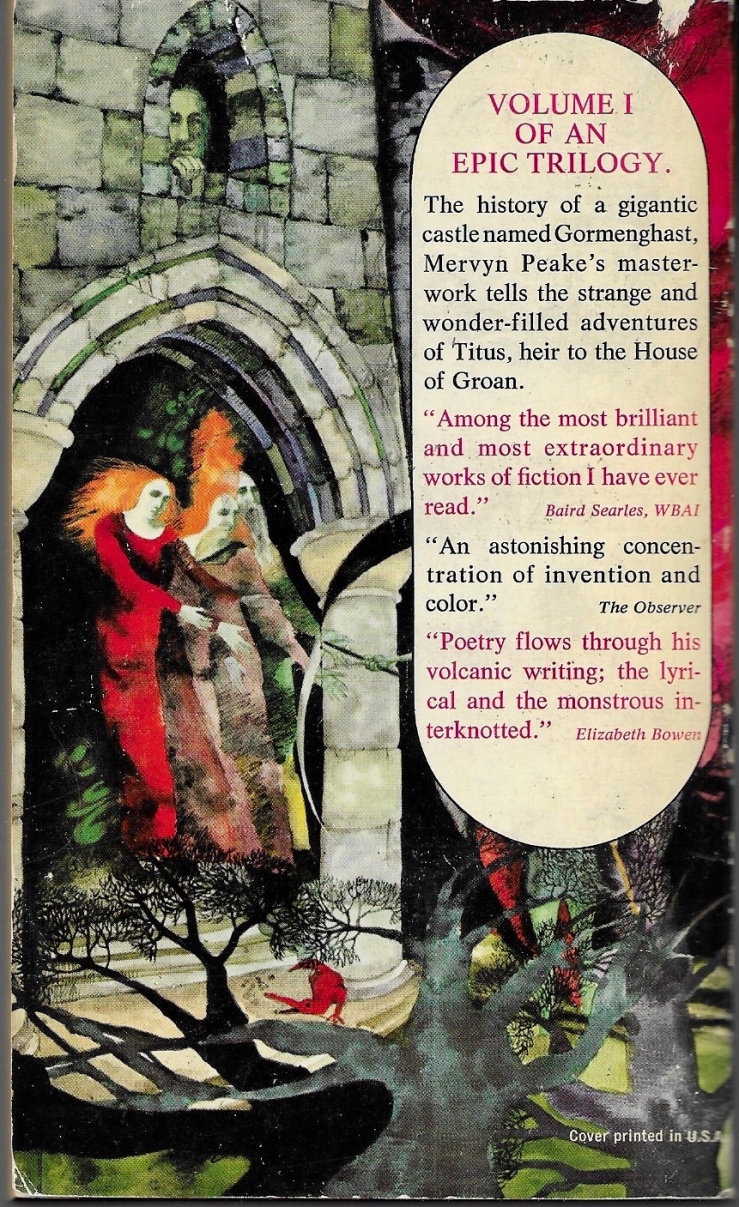
Titus Groan by Mervyn Peake. Mass-market paperback from Ballantine Books, 1968. Cover art by Bob Pepper (not credited); no designer credited.
The first of Mervyn Peake’s strange castle (and then not-castle trilogy (not really a trilogy, really)), Titus Groan is weird wonderful grotesque fun. Inspirited by the Machiavellian antagonist Steerpike, Titus Groan can be read as a critique of the empty rituals that underwrite modern life. It can also be read for pleasure alone.


Gormenghast by Mervyn Peake. Mass-market paperback from Ballantine Books, 1968. Cover art by Bob Pepper (not credited); no designer credited.
Probably the best novel in the trilogy, Gormenghast is notable for its psychological realism, surreal claustrophobia, and bursts of fantastical imagery. We finally get to know Titus, who is a mute infant in the first novel, and track his insolent war against tradition and Steerpike. The novel’s apocalyptic diluvian climax is amazing.


Titus Alone by Mervyn Peake. Mass-market paperback from Ballantine Books, 1968. Cover art by Bob Pepper (not credited); no designer credited.
I don’t usually include back covers in these Three Books posts, but I just love the way that Bob Pepper’s back-covers segue into each other.
Is Titus Alone my favorite in the trilogy, or is it just the one I read last? I don’t know. It’s a kind of beautiful mess, an episodic, picaresque adventure the breaks all the apparent rules of the first two books. The rulebreaking is fitting though, given that Our Boy Titus (alone!) navigates the world outside of Gormenghast—a world that doesn’t seem to even understand that a Gormenghast exists (!)—Titus Alone is a scattershot epic. Shot-through with a heavy streak of Dickens, Titus Alone never slows down enough for readers to get their bearings. Or to get bored. There’s a melancholy undercurrent to the novel. Does Titus want to get back to his normal—to tradition and the meaningless lore and order that underwrote his castle existence? Or does he want to break quarantine?
Titus Escapes might have been a better title for Peake’s third book, and its spirit of escape and adventure seem more compelling and comforting to me now than they did a month ago when I read this book.
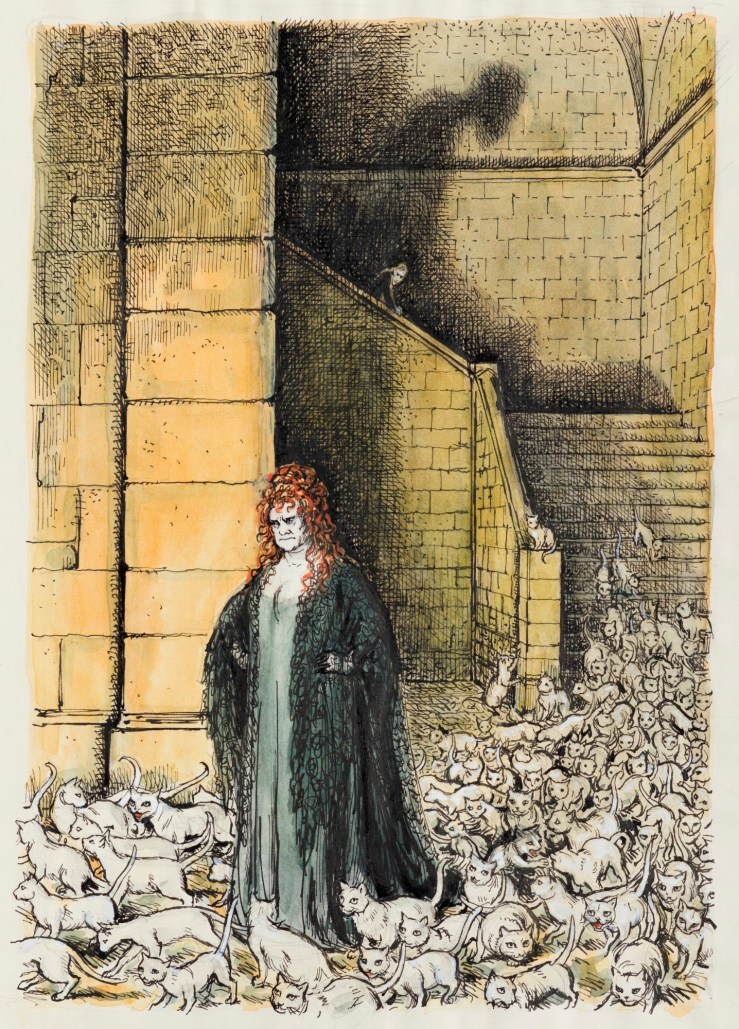
On the Way to the Doctor, 1974 by Charles W. Stewart (1915 – 2001).
Part of a series of unpublished illustrations that were to illustrate Mervyn Peake’s 1950 novel, Gormenghast. (More here.)
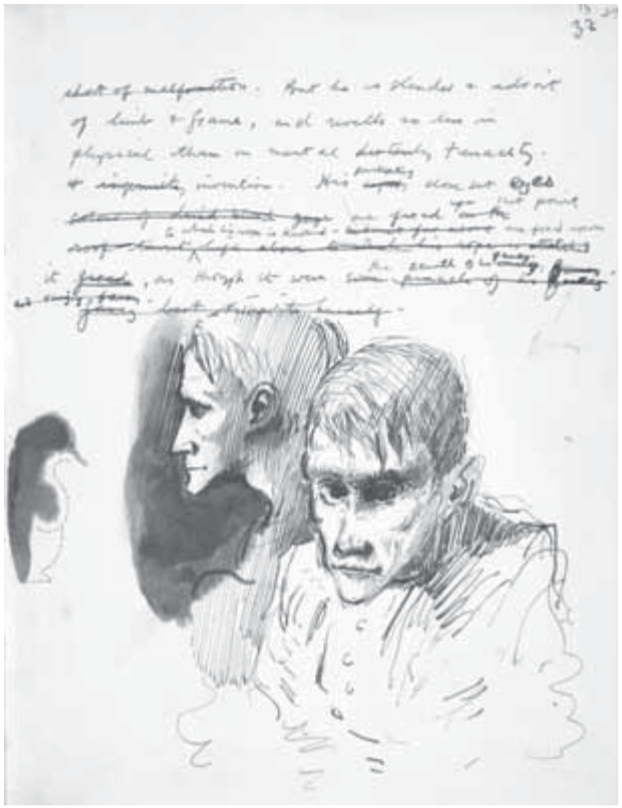
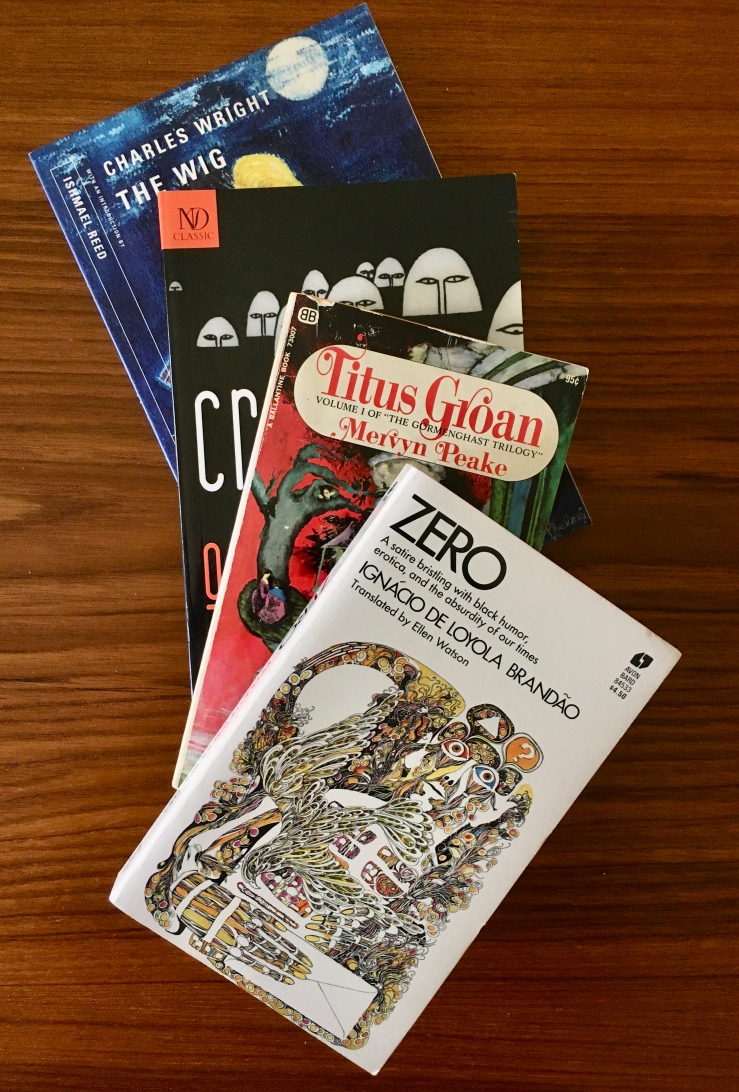
After one week of abstinence I drove the mile or so to the used bookstore I go to too often and browsed.
I was specifically looking for the other Gormenghast books by Mervyn Peake, the 1956 novella Boy in Darkness, and the unfinished Titus Awakes, completed by Peake’s wife Maeve after his death. I’m in the last few pages of Titus Alone, and I guess I don’t want to exit his proseworld just yet. Anyway, I went to this bookstore almost every week of February looking for Peake books with no luck after having picked up Gormenghast there on a lark a while back. I ended up buying the first and third of the Gormenghast trilogy online, because I couldn’t find them there, but today I found the complete trilogy in matching Ballantine editions. I did not find the other Gormenghast books though.
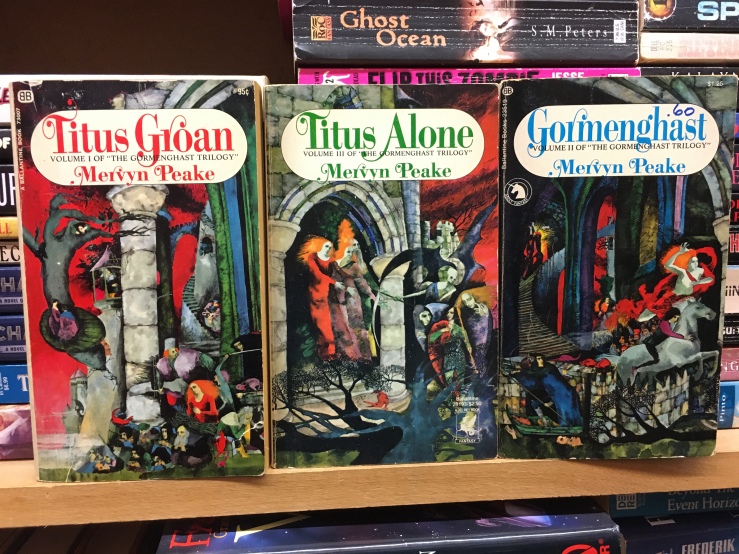
As much as I hated to break up the triplets pictured above, I picked up the Ballantine Titus Groan and adopted it to fit my other Ballantine editions. There is a specific student I have in mind whom I think will love the Penguin edition of Titus Groan I’ll give him next week (even though my dog bit it).
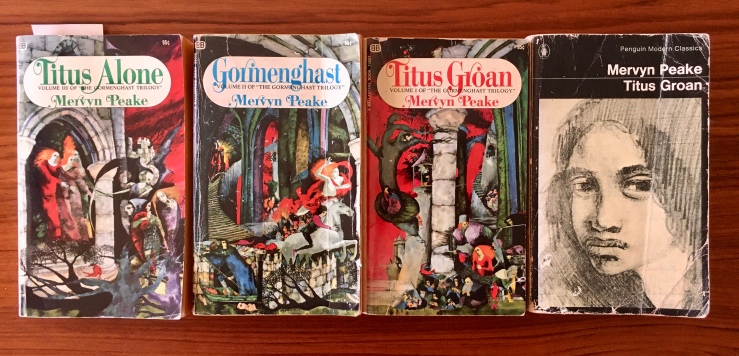
I’m obviously a sucker for covers, as any one who’s followed this blog for a while probably knows, and the Ballantine covers are better, I think—the Penguin editions of Peake’s trilogy are great, but they shy away from the bizarre nature of the narratives, tilting toward respectability.
Indeed, I like browsing in large part because I like the aesthetics of books, particularly older books. I absolutely loved this Edward Gorey cover for a 1957 edition of Joseph Conrad’s Victory—but I settled for a picture. I mean, I doubt I’ll read lesser-known Conrad at this point. But I love the orange and the blue, and Gorey’s handlettering:

I often settle for just a snapshot of a beautiful cover, like this bizarre one for The Family of Pascual Duarte by Camilo José Cela. I didn’t pick it up a few weeks ago, but then wished I had.

I had left it on the shelf like this, face outward. It wasn’t there today, and I wished that I had picked it up. Apparently it is brutal and was banned for a few years in its native Spain.
So well and anyway when I spied another Avon-Bard spine with a strange title I pulled it out, wowed at the cover, and dove in. Brazilian author Ignácio de Loyola Brandão’s Zero instantly struck a chord with me. The book is typographically all over the place, with text offset in boxes or laid out in columns. There are diagrams, enormous fonts, glypsh, citations, footnotes, etc. The book is a dystopian satire that seems to be written in its own idiom. The translation is by Ellen Watson. The wonderful cover art is uncredited (as far as I can tell).

I’ve never been able to get through Julio Cortázar’s famous book Hopscotch (despite many attempts), but I liked the short stories by him that I’ve read. I’m also a sucker for anything supershort, so when I saw his collection Cronopios and Famas (translated by Paul Blackburn), I was intrigued. I love a book in slices and morsels that I can snack on for a while (I’m really digging Gary Lutz’s The Complete Gary Lutz for the same reason). Most of the stuff in here is under three pages; much of it is much shorter too, like “Theme for a Tapestry”:

While scanning for anything by Rudolph Wurlitzer (no dice), I spied the spine of Charles Wright’s The Wig. Wright has been on my radar for a while now, mostly due to Ishmael Reed’s consistent endorsement of him (in both fiction and nonfiction alike), and when I pulled the volume to reveal its beautiful cover, I saw Reed’s name on the margin (and on the blurb on the back), and had to have it. The cover art is by Phelonise Willie; design by Scott di Giolamo:

So the grey arena formed itself and the crowd grew, while the domed ceiling of the dark place dripped, and the lamps were re-filled and some held candles, some torches, while others had brought mirrors to reflect the light, until the whole place swam like a miasma.
Were his shoulder not hurting from the grip it had sustained Titus might well have wondered whether he was asleep and dreaming.
Around him, tier upon tier (for the centre of the arena was appreciably lower than the margin, and there was about the place almost the feeling of a dark circus) were standing or were seated the failures of earth. The beggars, the harlots, the cheats, the refugees, the scatterlings, the wasters, the loafers, the bohemians, the black sheep, the chaff, the poets, the riff-raff, the small fry, the misfits, the conversationalists, the human oysters, the vermin, the innocent, the snobs and the men of straw, the pariahs, the outcasts, rag-pickers, the rascals, the rakehells, the fallen angels, the sad-dogs, the castaways, the prodigals, the defaulters, the dreamers and the scum of the earth.
My kind of people.
A wonderful view of the preterite underworld in Mervyn Peake’s Titus Alone.
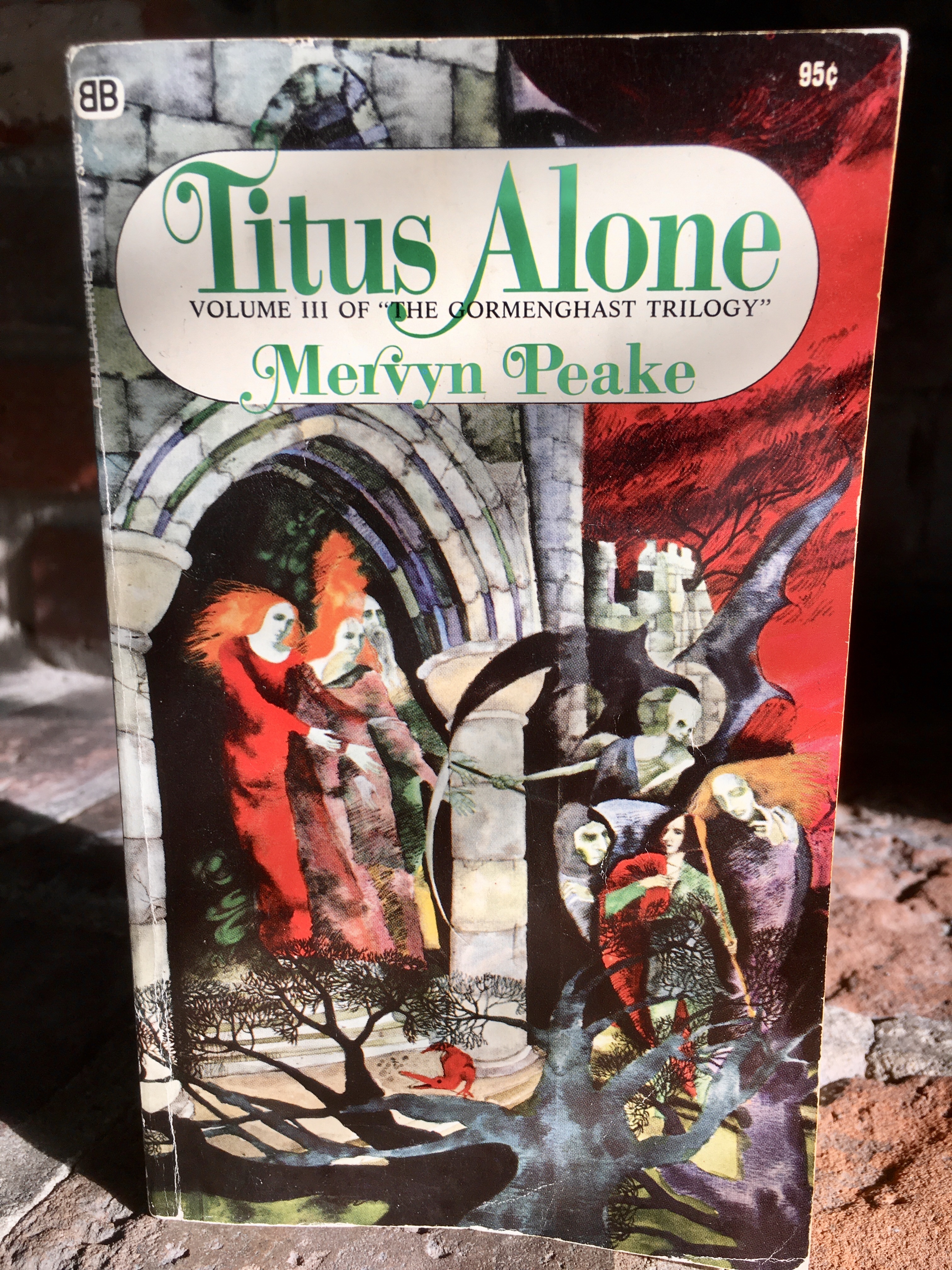

Not a dozen pages into Mervyn Peake’s 1959 novel Titus Alone something very strange happens: A man shows up in a car. The narrator simply uses the word “car,” and our hero Titus seems to accept the technological marvel in stride, using the word himself a bit later.
The strangeness of the car, a thing wholly banal in our own contemporary world, derives from its technological dissonance compared to the previous two Titus novels, Titus Groan (1946) and Gormenghast (1950).
These first two novels of the so-called “Gormenghast Trilogy” take place primarily in a strange, isolated castle called Gormenghast, and the limited terrain around it. The world of Gormenghast and environs seems medieval, stagnant, insular, but also wonderfully baroque, a world that centers on byzantine rituals that have been practiced and observed for at least seventy-seven generations. No one living knows what the rituals mean or from whence they derive; indeed, the rituals seem to be their own telos.
Tinged with fantastic and strange imagery, these first two novels are not fantasy per se, at least not in the traditional sense. They owe more to Charles Dickens’ novels than to the Nordic and Germanic myths that underwrite so much of Tolkien. The books are also wonderfully grotesque, full of weird mutants in varying stages of decay, imagery reflected in Peake’s illustrations for his books (which recall Leonardo’s caricatures). Peake’s prose style is singular as well: his syntax is thick, his vocabulary Faulknerian. Peake essentially creates an original idiom through which Gormenghast can exist. The world is so insular that it creates and sustains itself, both aesthetically and verbally.

Young Titus Groan is stifled by all of this insularity and apparently-meaningless ritual, however, and he escapes it at the end of Gormenghast. Somehow he arrives into a new world—the narrative logic is dreamy, perhaps because Titus arrives in this new world asleep in a boat, a positively mythic image. And then he’s picked up by the motorist Muzzlehatch, who feeds him and lets him rest and recover. Titus then witnesses a terrible battle between a camel and a mule, members of Muzzlehatch’s strange menagerie. After he leaves—he’s always leaving, always more or less alone, a word that repeats throughout Titus Alone—after Titus leaves Muzzlehatch, he arrives in a technologically-advanced city of glass and steel. He escapes flying surveillance drones and soon drops into a party (quite literally), where he meets Juno, a beautiful woman twice his age who will later take him as a lover. I should stop summarizing. Titus Alone is episodic, picaresque even, with one damn thing happening after another. The chapters are short and propulsive — most are no more than the front and back of a page. It’s just one damn thing happening after another, and happening with an energy and rapidity that seems the opposite of the methodical rhythm of the first two books. It reminds me of Voltaire’s Candide and Calvino’s The Baron in the Trees, both punchy picaresques, but also Carroll’s Through the Looking Glass or even Walter Murch’s 1985 film Return to Oz.
I passed a little over the half way mark of Titus Alone this afternoon. The book somehow has taken an even more surreal turn, as Titus enters the Under-River, a labyrinthine Hadean space under the city populated by outcasts and refugees. Peake’s overview of these underdwellers is cinematic and at times startling; he seems to point to a much larger universe, but one that Titus (and the reader) will never fully glimpse. And yet Titus Alone takes its hero (and the reader) into the new, into a world that must be rich and severe and stocked with lore—only Peake keeps us isolated from knowing. We are on the outside of knowing, alone.

Last week, browsing yon olde booke shoppe, I came across a battered but beautiful copy of Mervyn Peake’s novel Gormenghast. I can’t remember how or where I heard of Peake’s trilogy of not-quite-fantasy novels, but when I spied the spine I pulled it, loved the cover, and asked Twitter if the novels were any good. The answer seemed to be a resounding, Yes.
I picked up a Penguin Modern Classics edition of the first part of the trilogy, Titus Groan, along with the beautiful Ballantine edition of Gormenghast today. I also couldn’t resist a first edition of Sontag’s Under the Sign of Saturn.
I started Titus Groan today, and after pushing through its thick opening paragraphs, started to really dig it. The opening sentences are a bit of a hurdle. Here’s the first paragraph, thick and even foreboding in its diction and syntax:
Gormenghast, that is, the main massing of the original stone, taken by itself would have displayed a certain ponderous architectural quality were it possible to have ignored the circumfusion of those mean dwellings that swarmed like an epidemic around its outer walls. They sprawled over the sloping earth, each one half way over its neighbour until, held back by the castle ramparts, the innermost of these hovels laid hold on the great walls, clamping themselves thereto like limpets to a rock. These dwellings, by ancient law, were granted this chill intimacy with the stronghold that loomed above them. Over their irregular roofs would fall throughout the seasons, the shadows of time-eaten buttresses, of broken and lofty turrets, and, most enormous of all, the shadow of the Tower of Flints. This tower, patched unevenly with black ivy, arose like a mutilated finger from among the fists of knuckled masonry and pointed blasphemously at heaven. At night the owls made of it an echoing throat; by day it stood voiceless and cast its long shadow.
It was “the owls made of it an echoing throat” that made me want to keep going. Peake, like Faulkner or Cormac McCarthy, is a wordslinger. A few pages in he made me look up the word “recrudescent.” I was proud of myself a few pages later when Peake busted out “catalpytic,” which I guess I sort of knew (“a catalyptic mass of wine-drenched blubber” was the phrase). Describing some castle drudges getting drunks, he notes that they “attacked the bungs as though unweaned” which cracked me up. By the time little Titus is born, the book seems to make more sense to me: funny, thick, imaginative, but also abject, a bit gross, grotesque even, drunk on its own thick language.